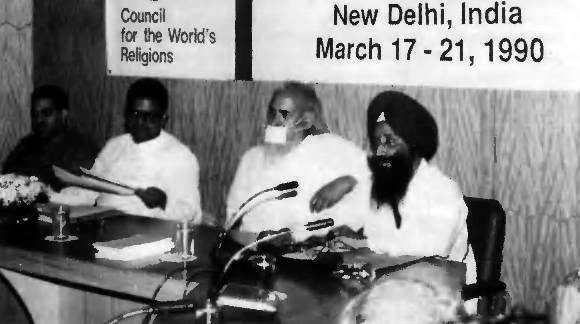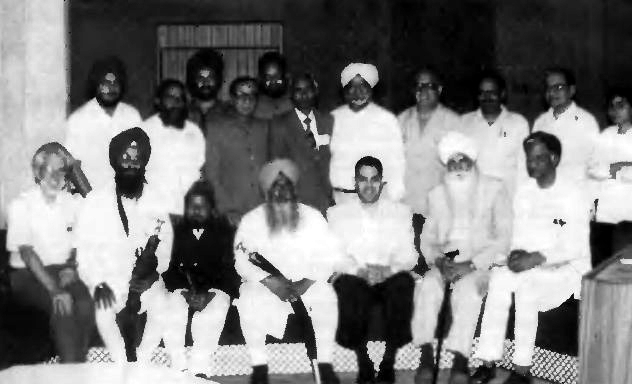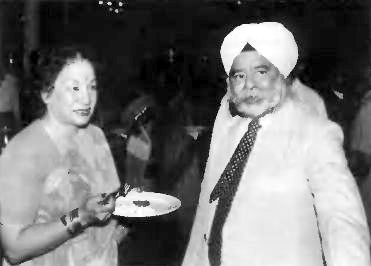![]()
The Words of the Kaufmann Family
|
|
The Words of the Kaufmann Family |

Seated
at the head table in the conference room at Hamdard University are,
from left to right: Dr. Frank Kaufmann; Sri Srivatsa Goswami, heir to
the Caitanya Vishnavait sect of Hinduism; Muni-ji Acharya Sushil
Kumar, world renowned Jain saint; Jathedar Manjit Singh, one of the
five foremost Sikh leaders in India
Places of Worship in Multi-faith India" was the title of a conference co-sponsored by the Council for the World's Religions (CWR), the Indian Institute of Islamic Studies and the Guru Nanak Foundation. Between March 17-20 of this year, against a backdrop of violent rioting, political maneuvering, and a nation longing for peace and resolution, 33 Indian dignitaries and people of influence gathered to work out answers.
The complex religious history of India has created a present situation which blisters with violent conflict, and national problems that defy resolution. It is a testimony to the human spirit that solutions are optimistically sought, and it is a greater testimony to the founders of the great religious traditions that their messages and insights provide the only legitimate ground upon which serious agendas for peace can be put forth.
In India, as in many places around the world, power-hungry politicians exploit religious sensibilities of the masses to suit their own needs and political agendas. Both leaders and common people succumb to this manipulation of their pride and honor, even going so far as to violate the teachings and fundamental principles of their respective faiths, and involving themselves in violence and aggression.
On the side-lines, members of the modern, secular media gladly fuel the flames of destruction in the hopes of selling more papers, winning the largest viewership on the six o'clock news, and promoting the flawed, scientistic ideologies by which one demonstrates oneself to be "modern," "enlightened," "objective" and "rational." Reportage and analysis of so-called "religious" phenomena is carried out by people (i.e., your average news reporter or editor) who know no more about religion and spirituality than the Dalai Lama knows about running a successful newspaper. Consequently world-wide consumers of "news" (including political, economic and cultural leaders) come to be convinced of the existence of "religious" wars, "religious" rioting or uprisings -- all misnomers.
Of course, people of different religions have a great deal about which they may potentially differ or even enter into conflict. But truly religious people have an infinitely greater potential to resolve conflicts because the very principles which define their lives are grounded in revelations and insights designed to bring peace and prosperity through humility and self-sacrifice. Here at the "Places of Worship" Conference, India's greatest religious leaders actually had to make their way past violent rioting in order to arrive at the conference site. Principal spokespeople for the three religions involved spent days together both representing the perfect compatibility of their respective faiths and applying that compatibility by intensely laboring together in search of solutions.
One participant described this conference as "a golden opportunity in my personal as well as academic life." Indeed, prominent leaders described this work as "unparalleled," and "sorely needed."

Conference
participants pose for the group photo
The issue for this particular conference involved, as the title explains, places of worship or sacred land.
Throughout its long history India has been ruled by powers which, at various times, identified themselves with different religions. There was a long period of Muslim ascendancy, as well as that of Hindus. The Sikhs also participated in this historical entanglement coming on to the scene somewhat later (from the early 16th century). With each change of ruling class, mighty warriors and emperors, anxious, as all people are, to attract God's favor, spent abundantly on their gods. These symbols of their devotion included building bigger and better places of worship, better than those of the former (vanquished) powers. And if these bigger and better places could be built on the former sites of the vanquished gods and their peoples, thus "erasing" all signs of the "false" and "weaker" powers, so much the better.
Now the war games of that particular sort are over, and India attempts to govern itself as a secular democracy, granting equal rights to all religious believers. But history has left this land with mosques where temples once were, temples where mosques once were, sacred burial grounds occupying now valuable land, and a host of other historical legacies that muddy the contemporary waters.
All nations face a unique challenge of historic restoration as they struggle to establish an ideal standard for national existence in the modern world. In this way, each nation must not merely learn what the ideal structures are, but must also clear the way, through restoration principles, for that ideal structure to be implanted. This is a little-known reality in contemporary analyses of current geo-politics.
India has long sought an ideal for inter-religious harmony, and for this reason has the potential to become a world leader in this area, especially to those nations which have not even held such harmony at least as an ideal.
As we know, restoration is best achieved through clear, precise patterns. Those nations which embrace and welcome the CWR as a peacemaker in their national growth and development, are indeed enhancing the possibility of inheriting these specific principles of restoration. In India we have a nation which both has long held the ideal of inter-religious harmony and cooperation and has welcomed the CWR in a big way into its national affairs. The current Prime Minister of India, VP Singh, sent a letter of commendation and encouragement to the conferees which was read at the conference inauguration.
For this reason India may be blessed by seeing an end to its internal strife, but so much hard work yet remains.
As for specifics, the big issues for this conference were: (1) the massacre of Sikh worshippers by government troops in the Golden Temple in Amritsar, following the assassination of Prime Minister Indira Gandhi; and (2) what is known as the Ram Janma Bhoomi-Babri Masjid controversy -- Ram Janma means the temple which marks the site of the legendary birthplace of the God Ram (a Hindu holy place), and Bhoom-Babri Masjid is the name of the Muslim mosque which presently stands on the grounds of that site.
Both issues burn on the present political scene. The latter virtually dominated the most recent Indian national elections. Who then would dare gather the very leaders of each of these religious communities (Hindu, Muslim and Sikh) and put them together, in the public eye, in search of peace and resolution?

Two
participants converse over lunch
The risk paid off. The conference was attended by the foremost representatives of the religions involved. Two Jathedars (the very highest leaders of Sikhs), Imams (Muslim), Hindu Priests, Acharyas (a title of honor or sainthood in Jain and other Indian religious traditions), University Vice-Chancellors, Supreme Court Justices, foundation founders and presidents, commercial leaders, journalists, students, monks and holy men And women, worked together. Press conferences were held, television crews were sent to cover the inaugural banquet (which I k as attended by parliamentarians, ambassadors and other city, state and national leaders), and religious communities around the city held special services to welcome the conferees. A number of important papers were presented from which a CWR Report will be compiled for the research use of policy makers.
So does it all make any difference? Does the fighting become less? I say yes. In the land of fast food and instant winners one may find skeptics about the process. But men and women seriously involved in human and social transformation know that the deep problems require great and prolonged investment, before lasting change can occur. For millennia the power of self-interest has been generating ideologies and human institutions which, for the petty gain of a few, breed resentment, war, and degraded human existence. The process of building peace requires an even greater commitment on the part of those involved in creating ideologies and social institutions designed to promote peace and the flourishing of human goodness.
The process can happen only one step at a time, but this conference was a very big step.